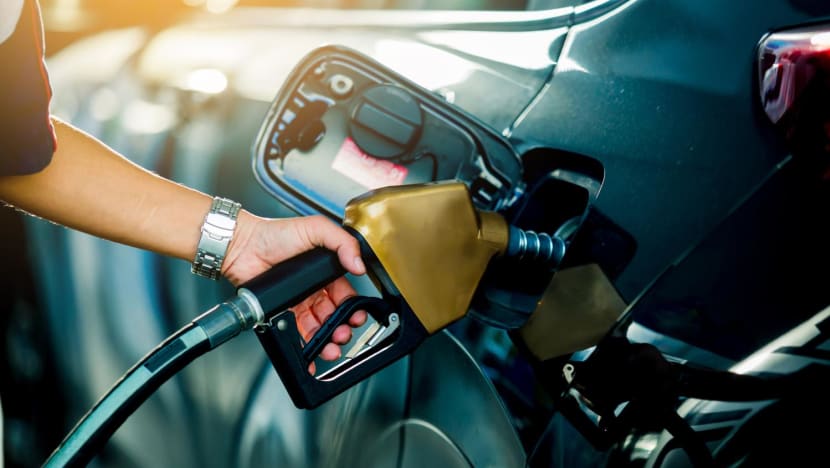Petrol prices to remain high amid Russia-Ukraine conflict; drivers already feeling the pinch

A person refilling the car with fuel at a petrol station. (Photo: iStock/Koonsiri Boonnak)
SINGAPORE: Motorists in Singapore, who are already paying more to fill up their tanks at the petrol station, could face even higher prices on their next visits.
Pump prices have been on an accelerated uptrend in recent weeks following Russia’s invasion of Ukraine, and experts are expecting uncertainties over the conflict to fuel further increases.
According to fuel price comparison website Fuel Kaki on Friday afternoon (Mar 11), the most popular 95-octane grade petrol is going at a range of S$3.19 to S$3.23 a litre, up as much as 32 cents this week.
Selling at S$3.15 to S$3.16 a litre, prices of the 92-octane petrol have risen by as much as 24 cents this week. Likewise for the premium 98-octane grade, with prices ranging from S$3.66 to S$3.72 a litre on Friday.
Diesel prices are up more than 30 cents this week to retail between S$2.88 to S$2.90.
Meanwhile, international oil markets have been on a rollercoaster ride, scaling multi-year highs on Tuesday when the United States announced a ban on Russian energy imports then diving sharply in the days after as concerns about supplies eased. Russia is one of the world’s top three oil producers after the United States and Saudi Arabia.
Brent crude futures were last seen about 2 per cent higher at US$111.44 a barrel on Friday afternoon, while the US West Texas Intermediate (WTI) crude rose by 1.6 per cent to US$107.80 a barrel.
Before the geopolitical crisis, global energy markets were already grappling with a crisis owing to a spike in demand as world economies recover from the COVID-19 pandemic, tight supplies and pandemic-induced supply chain disruptions.
“There is plenty of doom and gloom going around about oil prices now,” said Oanda’s senior market analyst Jeffrey Halley, adding that any price dips are set to be short-lived.
While global oil prices are unlikely to reach the levels of US$200 a barrel as some market watchers have predicted, Mr Halley is not ruling out the possibility of Brent crude rising to US$150.
“The price for replacing Russian energy will be some countries and sectors coming in from the cold, and I have no doubt that will happen,” he wrote in a note. “Still, a switch can’t magically be switched on to increase production around the world. That will take time.”
To be sure, petrol retailers in Singapore do not use crude oil prices in their cost accounting and pricing decisions for pump petrol. The Mean of Platts Singapore (MOPS) prices – the wholesale price of refined oil published by markets research firm S&P Global Platts – is used instead.
Other considerations that go into the pricing decisions of retailers include duties, the cost of storage, land and labour, as well as currency differences. There is also typically a “lag effect” given how pump prices are based on older inventories bought at either higher or lower prices depending on the market situation then.
But the lag time between global oil price movements and what consumers are paying at the pump has been much shorter this time.
“What is perhaps more unique about the current set of events and price movements in recent weeks include that we are still in the midst of a global energy crunch and that there is a scale and sense of permanence to the changes in demand for oil and gas from Russia that will coincide with a re-calibration of global supply chains,” said Dr David Broadstock, senior research fellow and head of the energy economics division at the National University of Singapore’s (NUS) Energy Studies Institute.
CIMB Private Bank economist Song Seng Wun said: “The pass-through effect is much faster this time because the spike in global oil prices has been so abrupt and so sharp over a short period of time. Also from the refineries’ standpoint, it doesn’t look like the situation is going to dissipate anytime soon.
“Even if the war in Ukraine stops, to what extent will the sanctions remain in place? Russia and Ukraine are not unimportant in the world of resources and energy, so the worry goes beyond the current crisis and into the far longer term.”
At the same time, other costs are going up. For one, petrol retailers face the pressure of rising labour cost, just like any other business in Singapore.
“Existing pressure points, be it labour or land, will never go away,” Mr Song added. “What is far more serious is that the cost of moving goods have become more expensive because of the conflict in Eastern Europe.”
Refineries and oil importers are paying more for freight rates as global supply chains brace for even more disruptions, as well as higher insurance premiums for their goods during transit, he explained.
All this means that the making of petrol or diesel is set to become more expensive and the additional costs will likely be passed on to consumers.
While there is confidence that other members of the global oil and gas supply chain are willing to expand production to make up for the supply shortfall from Russia, Dr Broadstock said the market remains in the middle of a volatile price period and has not seen “convincing signals of … a return to sub-US$100 prices for oil”.
“In other words, we are still seeing the market dance around the fringe of high prices – a ballet of sorts between high, higher and highest,” he added.
“These are very likely powerful signals to petrol retailers and would presumably sustain their expectation that fuel will need to be sold at a higher price.”
“WE JUST HAVE TO TRY TO BE OPTIMISTIC”: TAXI DRIVER
Motorists are already feeling the pinch, especially taxi drivers and private-hire car drivers who clock long hours on the road.
Mr Chan KS, a taxi driver with ComfortDelGro, said he used to spend about S$15 a day on diesel. That has now gone up to S$25, even though he fills up his tank at kiosks operated by ComfortDelGro which offers discounted rates.
“This time last year we were paying about S$1, but now it’s S$1.65. The jump has been drastic and unfortunately, I foresee it will go higher to maybe S$2 if the conflict in Ukraine is going to be prolonged.”
The rise in fuel costs is coming at a time when passenger demand has yet to return to pre-pandemic days with remote working still in place and continued competition from ride-hailing apps.
Higher fares, which kicked in this month for ComfortDelGro and other taxi operators, have also deterred some passengers, Mr Chan told CNA.
If the situation persists, the cabbie, who has been on the roads for the past 15 years, hopes that taxi operators can consider having a temporary fuel surcharge, just like they did in 2008 when a 30-cent fuel surcharge was levied on each taxi ride for about four months.
“For now, we just have to try to be optimistic,” said Mr Chan, adding that he may switch off his engine to cut cost if he ends up in long queues at waiting bays.
CNA contacted five taxi operators and four ride-hailing firms to ask how they intend to support their drivers through this period.
Among those that replied, ride-hailing firm Gojek said it already has several initiatives to help drivers with fuel costs, such as discounts at certain petrol stations and card rebates.
It added that it is “monitoring the situation closely amid the changing circumstances and will continue to actively explore ways to support the welfare of driver partners”.
Likewise, TADA said it is “committed to studying all the possible measures to alleviate rising cost pressures whilst also minimising the corresponding impact on ride fares”.
“We are not able to comment on the specifics until we receive regulatory approval,” said general manager Jonathan Chua.
ComfortDelGro, Singapore's largest taxi company, said its recent fare adjustment is one form of support for cab drivers, who also receive continued rental waivers.
In addition, those who drive for the entire month of March will qualify for a one-time S$90 rental rebate. Those who do not will still get a pro-rated rebate, said group chief branding and communications officer Tammy Tan.


















